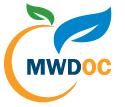Rachel Waite, Water Use Efficiency Analyst II, MWDOC
 The California Department of Water Resources (DWR) recently released the long awaited Proposition 1 Integrated Regional Water Management (IRWM) Implementation Grant Draft Funding Recommendations for the Santa Ana Watershed Project Authority (SAWPA) and South Orange County Watershed Management Areas (SOCWMA), respectively. The recommendations from both Watershed Management Areas are to include awards for two MWDOC-submitted proposals totaling $3,600,346.
The California Department of Water Resources (DWR) recently released the long awaited Proposition 1 Integrated Regional Water Management (IRWM) Implementation Grant Draft Funding Recommendations for the Santa Ana Watershed Project Authority (SAWPA) and South Orange County Watershed Management Areas (SOCWMA), respectively. The recommendations from both Watershed Management Areas are to include awards for two MWDOC-submitted proposals totaling $3,600,346.
The SAWPA Watershed Management Area recommendation, which covers North and Central Orange County, includes $2,767,344 for the Regional Comprehensive Landscape Rebate Program submitted by MWDOC through the IRWM process. This is a collaborative water efficiency effort, led by MWDOC, among water agencies in the Santa Ana River Watershed that include Big Bear Lake Department of Water, Eastern Municipal Water District, Inland Empire Utilities Agency, San Bernardino Valley Water District, and Western Municipal Water District. The South Orange County Water Management Area recommendation includes $833,002 for the South Orange County Water Use Efficiency Program, which promotes water efficiency across southern Orange County.
The Regional Comprehensive Landscape Rebate Program and the South Orange County Water Use Efficiency Program will both utilize consumer-based rebates to facilitate water efficient and holistic landscape transformations across Orange County and the upper Santa Ana Watershed. These programs are available to residential, commercial, public, and industrial landscapes and focus on the replacement of turf grass with California Friendly landscapes; the installation of EPA Water Sense-labeled smart irrigation controllers and efficient irrigation techniques; and the use alternative irrigation sources, such as rain water or municipally supplied recycled water.
An estimated 3,295 acre feet of water will be annually saved in the Santa Ana Watershed and South Orange County as a result of both Programs. Additional estimated benefits include: stormwater and dry weather runoff reductions of over 4,000,000 gallons per year; energy savings of over 10 million kilowatt hours per year which will reduce carbon dioxide emissions by over 8,000 metric tons per year; and a greater than 420,000 pound increase of urban biomass that will sequester over 210,000 pounds of carbon from the atmosphere.
We look forward to working with our project and funding partners over the next several years to implement these important, water saving projects.

